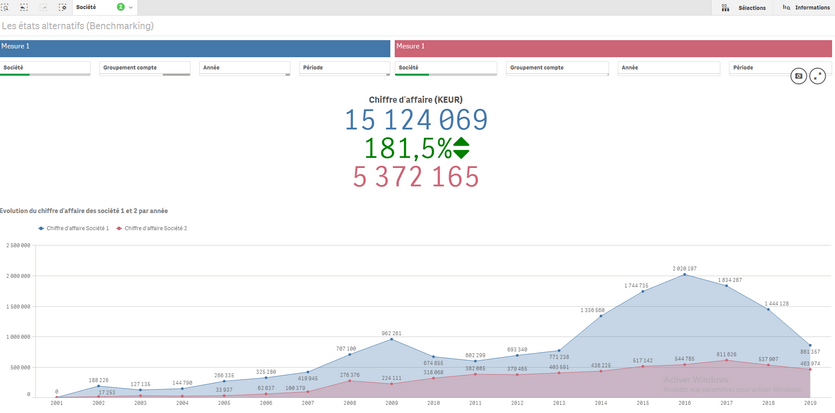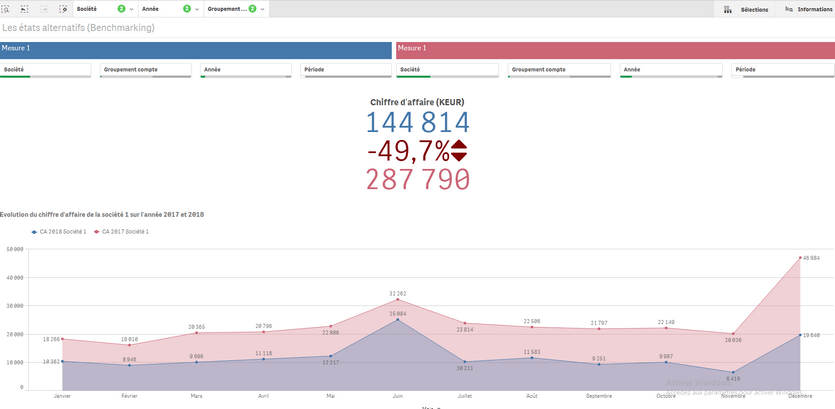The importance of alternative states and benchmarking
In any business analysis, it is often very relevant to carry out comparative analyses between different entities in order to be able to draw major lessons from the data for all the departments of a company.
For example :
- In finance, it is very common to want to compare financial performance measures (margin or cash KPIs for example) of an entity (such as a company, department or product) over time or across these different entities.
- In marketing, for example, we would rather compare the performance (in terms of lead generation or ROI) of different marketing campaigns or compare the buying behaviour of different groups of customers (according to their characteristics) over a given period.
- In human resources, benchmarking is often linked to employee compensation by evaluating different functions or by comparing the salaries of specific functions across companies or industries. The trend today is also to be able to compare the performance of production activities or to compare one’s HR policy with the best players on the market.
Use of the Qlik Sense tool for benchmarking.
The Qlik Sense Business Intelligence tool is equipped with a very interesting functionality to carry out comparative analyses (benchmarking) through different axes. This functionality is called alternative states and is directly derived from the principle of associativity of Qlik Sense, which is at the heart of its operation.
Its use is very simple and sometimes allows to summarize the whole of a specific application in a few dynamic visualizations. The user simply has to choose the analysis axes that interest him and the measurements linked to these states are then automatically updated according to the selection made.
Customize alternative states with Qlik Sense
Thanks to the alternative reports, it is possible to cross-reference measurements and analytical dimensions intuitively and dynamically, which makes the possibilities in terms of analysis virtually unlimited.
The very simple example below illustrates how alternative states work. It is taken from a small financial application made for the occasion containing the accounting movements of three company codes over a given period.
Two alternative reports have been created (state 1 and state 2). The first state (state 1) has been applied to measure 1 (blue) and the second state to measure 2 (red). The measure used here is simply the sum of the debits and credits of the accounting movements.
Suppose we want to compare the turnover of two companies over the years. To do this, we simply choose company 1 and the turnover for measure 1 and company 2 and the turnover for measure 2.

It can be seen that over the years as a whole, Company 1 has a turnover 181.5% higher than Company 2.
Now suppose we want to compare the 2018 turnover of Company 1 with the 2017 turnover of the same company. To do this, we simply choose Company 1, the year 2018 and the turnover in the filters of alternative state 1 and Company 1, the year 2017 and the turnover in the filters of alternative state 2.

It can be seen that Company 1 experienced a loss of 49.7% of its turnover between 2017 and 2018.
We have seen from these examples that the alternatives states are very simple to use and can offer a very interesting analysis power in any field of application.
Alternative statements are often used in our applications for financial departments, you can discover examples of analyses regularly implemented on our “Finances” page.
Enhance your Qlik Sense applications with our expertise
Want to enhance your Qlik Sense applications ? As a certified Qlik partner, our Qlik experts support you in setting up your projects and choosing the most suitable visuals for your Qlik Sense & Qlikview applications
Contactez-nous si vous avez une question ?
Laetitia Larchanche
Keep up to date with the latest WeQan news by following us on LinkedIn and Facebook.
